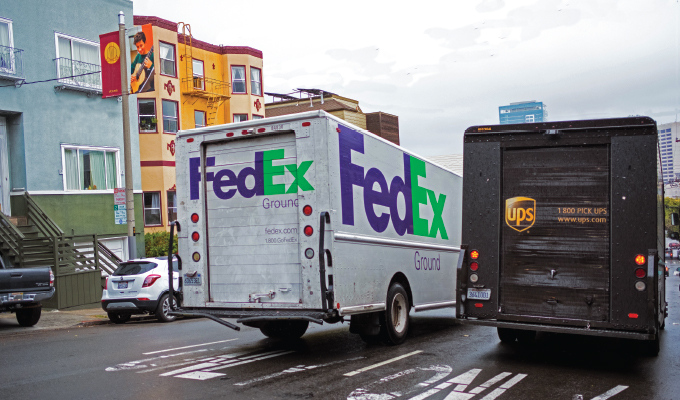By Vardan Markosyan
Reducing transportation costs is a common challenge of last-mile delivery. Getting the package to the final destination can be one the most difficult stages in supply chain management. Due to the COVID-19 pandemic e-commerce is on the rise, and we have seen a significant shift to online shopping. As a result, businesses look for ways to minimize costs and develop technological solutions, such as the delivery route planner. With cloud-based delivery route planner software, drivers are given directions to all locations in real time, and the order of these is updated automatically to optimize the journey.
LAST-MILE INDUSTRIES
Last-mile deliveries can be challenging in a number of sectors. Deliveries to businesses in an urban area can cause congestion and safety issues. Getting packages to individuals is also difficult as last-mile delivery costs are often higher due to complicated routes, more destinations, and the need for a larger workforce. Here are a few examples of the types of industries involved in last-mile deliveries:
- Wholesale distribution: Wholesale distributors rely on delivery mainly to other businesses.
- Retail deliveries: Many retailers now offer delivery services. There has been a particular increase in supermarket deliveries, for example.
- E-commerce: With more people shopping online, there are more e-commerce businesses than ever. Depending on the size of the business, last-mile deliveries can be more problematic and costly due to the increase in demand.
- On-demand deliveries: On-demand deliveries give consumers, businesses, and individuals the option to receive their package in a matter of hours.
COVID & LAST MILE
The COVID-19 pandemic has brought both challenges and opportunities to last-mile delivery transportation. Safety concerns and social distancing restrictions have led to an increase in deliveries. Many consumers also expect next-day deliveries and a more efficient service. Here are some examples of the current trends associated with delivery and transportation due to COVID-19.
- Increased online orders and deliveries: The pandemic caused a surge in online orders and deliveries. Many businesses struggle to cope with this rise in demand.
- Longer delivery times: Many businesses report longer than usual delivery times. This is mainly due to the increase in orders and overwhelmed companies.
- Increased number of late deliveries: There have also been more late deliveries. Many businesses use technological solutions in order to give their customers notification of delays to avoid complaints.
NEXT-DAY DELIVERY
In order to stay ahead of their competitors, many businesses offer next-day deliveries. This is not without its own challenges, however, and unfortunately it’s not worth it for some small businesses to offer. There are several issues with next-day deliveries.
- Too many unnecessary driven miles: Next-day delivery means more journeys and increased labor costs. Drivers have to cover more miles to deliver fewer goods.
- Too many trucks used: To ensure next-day delivery, companies also need to invest in more vehicles. This causes both financial and environmental problems.
- Time spent on the delivery planning and scheduling: With next-day delivery, the company is on the clock from the moment the order has been placed. They then need to plan the best route and aim to get as many packages delivered on time as possible.
It is, however, easier to optimize next-day delivery with the help of technology solutions. If you operate next-day delivery you can cut off orders at a certain time, and then plan the most efficient routes for the following day. Delivery route planner software can help you do this.
TECHNOLOGY SOLUTION
There are several new technology solutions that can help businesses reduce transportation costs in a post-COVID reality. These allow businesses to plan their routes and optimize various stages of the delivery process.
- Realistic route planning: Realistic route planning software calculates the best route when visiting multiple locations. It automatically reorders destinations according to a variety of factors. These could be traffic or weather conditions. Delivery route planner software also continually updates your route in real time, giving the driver a realistic timeframe for each destination and providing them with clear directions to follow.
- Digital dispatch and communication: New innovative platforms facilitate better communication between the dispatcher and the driver. These types of digital dispatch applications not only control dispatching, but also call taking, employee scheduling, and storage lot management.
- ETA and delivery window tracking: With route planner software, drivers are given a more realistic ETA that is constantly updated. Customers are also provided with a more accurate ETA, and they can also track their delivery.
With delivery route planner technology, more businesses are able to manage the rise in demand. The costs of delivery can be reduced and the whole process is optimized. This is especially important in last-mile delivery, which can be the most challenging and costly for many businesses.
Many factors contribute to the cost of last-mile delivery. These include driver speed, downtime, and failed deliveries. More complicated routes and an increase in stops can also cause drivers to travel unnecessary miles. This is where delivery route planner technology can help. It allows businesses to manage their fleet, increase delivery capacity, and minimize failed deliveries. It can solve the problem of last-mile delivery once and for all.
ABOUT THE AUTHOR
Vardan Markosyan is the CEO at Less Platform. He spent decades of research and consultancy on business process optimization and system design. Find out more, visit www.lessplatform.com.




